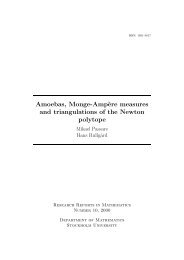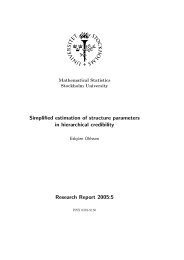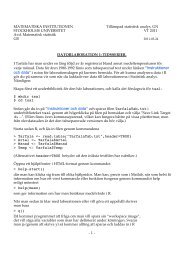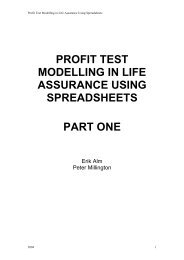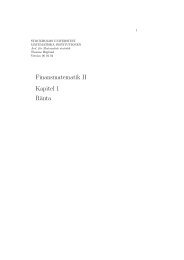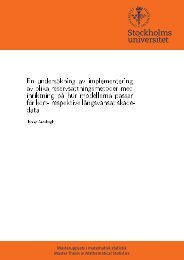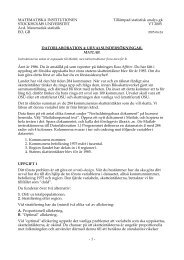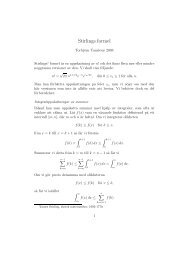This is a preprint of an article accepted for publication in the ...
This is a preprint of an article accepted for publication in the ...
This is a preprint of an article accepted for publication in the ...
Create successful ePaper yourself
Turn your PDF publications into a flip-book with our unique Google optimized e-Paper software.
<strong>Th<strong>is</strong></strong> <strong>is</strong> a <strong>prepr<strong>in</strong>t</strong> <strong>of</strong> <strong>an</strong> <strong>article</strong> <strong>accepted</strong> <strong>for</strong> <strong>publication</strong> <strong>in</strong> <strong>the</strong>Sc<strong>an</strong>d<strong>in</strong>avi<strong>an</strong> Actuarial Journal © 2008Taylor & Fr<strong>an</strong>c<strong>is</strong>; Sc<strong>an</strong>d<strong>in</strong>avi<strong>an</strong> Actuarial Journal <strong>is</strong>available onl<strong>in</strong>e at: http://journalsonl<strong>in</strong>e.t<strong>an</strong>df.co.uk/
Ma<strong>the</strong>matical Stat<strong>is</strong>ticsStockholm UniversityCredibility estimators <strong>in</strong> multiplicative modelsEsbjörn OhlssonResearch Report 2006:3ISSN 0282-9150
Postal address:Ma<strong>the</strong>matical Stat<strong>is</strong>ticsDept. <strong>of</strong> Ma<strong>the</strong>maticsStockholm UniversitySE-106 91 StockholmSwedenInternet:http://www.math.su.se/matstat
Ma<strong>the</strong>matical Stat<strong>is</strong>ticsStockholm UniversityResearch Report 2006:3,http://www.math.su.se/matstatCredibility estimators <strong>in</strong> multiplicative modelsEsbjörn Ohlsson ∗March 24, 2006AbstractRat<strong>in</strong>g <strong>of</strong> non-life <strong>in</strong>sur<strong>an</strong>ce contracts commonly employs multiplicative models that areestimated by Generalized L<strong>in</strong>ear Models (GLMs); <strong>an</strong>o<strong>the</strong>r useful tool <strong>for</strong> rate mak<strong>in</strong>g <strong>is</strong>credibility models. The ma<strong>in</strong> goal <strong>of</strong> th<strong>is</strong> paper <strong>is</strong> to demonstrate how <strong>the</strong>se c<strong>an</strong> be comb<strong>in</strong>edto solve import<strong>an</strong>t practical problems, <strong>in</strong> particular <strong>the</strong> car classification problem <strong>in</strong>motor <strong>in</strong>sur<strong>an</strong>ce. <strong>Th<strong>is</strong></strong> <strong>is</strong> achieved by re<strong>for</strong>mulat<strong>in</strong>g <strong>the</strong> credibility models as multiplicativer<strong>an</strong>dom effects models, where <strong>the</strong> GLM estimates are used as “a priori differences”.Our models have various elements <strong>in</strong> common with, <strong>in</strong> cronological order, Sundt (1987),D<strong>an</strong>nenburg, Kaas & Goovaerts (1996), Nelder & Verall (1997) <strong>an</strong>d Bühlm<strong>an</strong>n & G<strong>is</strong>ler(2005, Chapter 4.13). The methods are illustrated on data from a Swed<strong>is</strong>h <strong>in</strong>sur<strong>an</strong>cecomp<strong>an</strong>y.KeywordsCredibility <strong>the</strong>ory, Hierarchical credibility, Generalized l<strong>in</strong>ear models, GLMs, Car modelclassification, Motor <strong>in</strong>sur<strong>an</strong>ce, Multi-level factor.∗ Ma<strong>the</strong>matical Stat<strong>is</strong>tics, Stockholm University, <strong>an</strong>d Länsförsäkr<strong>in</strong>gar Alli<strong>an</strong>ce.E-mail: esbjorn.ohlsson@math.su.se
2 1 INTRODUCTION1 IntroductionCredibility estimators are useful <strong>in</strong> <strong>the</strong> process <strong>of</strong> rat<strong>in</strong>g non-life <strong>in</strong>sur<strong>an</strong>ce contracts, but <strong>in</strong>our experience, credibility <strong>is</strong> not used as much <strong>in</strong> practice as it deserves. Non-life actuariescommonly employ multiplicative models, where a number <strong>of</strong> rat<strong>in</strong>g factors are estimated byGLMs (Generalized L<strong>in</strong>ear Models). Most texts on credibility <strong>the</strong>ory tend to ignore th<strong>is</strong> fact,giv<strong>in</strong>g little or no guid<strong>an</strong>ce on how to use credibility estimators <strong>in</strong> th<strong>is</strong> multiplicative GLMenviroment. To bridge <strong>the</strong> gap between GLMs <strong>an</strong>d credibility, we suggest here that credibilitymodels are stated as multiplicative r<strong>an</strong>dom effects models. Credibility <strong>an</strong>d GLMs c<strong>an</strong> <strong>the</strong>neasily be comb<strong>in</strong>ed to mixed models (GLMMs) with <strong>the</strong> familiar multiplicative structure <strong>for</strong><strong>the</strong> me<strong>an</strong> (log-l<strong>in</strong>k).Ano<strong>the</strong>r fact that “hampers <strong>the</strong> accept<strong>an</strong>ce <strong>of</strong> credibility techniques by practicioners” wasnoted by D<strong>an</strong>nenburg, Kaas & Goovaerts (1996): that “credibility <strong>is</strong> currently taught <strong>in</strong> <strong>an</strong>eedlessly complicated way” <strong>an</strong>d that credibility <strong>is</strong> “set <strong>in</strong> a Bayesi<strong>an</strong> framework”. They suggestreplac<strong>in</strong>g <strong>the</strong> Bayesi<strong>an</strong> sett<strong>in</strong>g, with <strong>an</strong> abstract r<strong>is</strong>k parameter Θ, by vari<strong>an</strong>ce componentmodels (additive r<strong>an</strong>dom effects models). We f<strong>in</strong>d th<strong>is</strong> a very clever <strong>an</strong>d useful re<strong>for</strong>mulation<strong>of</strong> credibility <strong>the</strong>ory, but we prefer us<strong>in</strong>g multiplicative models, s<strong>in</strong>ce <strong>the</strong>se are commonpractice <strong>in</strong> GLM rat<strong>in</strong>g.The idea <strong>of</strong> comb<strong>in</strong><strong>in</strong>g credibility <strong>an</strong>d GLMs <strong>is</strong> not new: it was <strong>in</strong>troduced by Nelder & Verall(1997), us<strong>in</strong>g <strong>the</strong> HGLMs (Hierarchical Generalized L<strong>in</strong>ear Models) <strong>of</strong> Lee & Nelder (1996);however, <strong>the</strong>ir approach uses <strong>the</strong> concept <strong>of</strong> hierarchical likelihood which, presumably, <strong>is</strong> notfamiliar to most actuaries. We prefer here to stay with <strong>the</strong> d<strong>is</strong>tribution-free <strong>an</strong>d simple BLP(best l<strong>in</strong>ear predictor) approach that <strong>is</strong> st<strong>an</strong>dard <strong>in</strong> credibility <strong>the</strong>ory.One might say that <strong>the</strong> present paper comb<strong>in</strong>es <strong>an</strong> idea by D<strong>an</strong>nenburg et al.—deriv<strong>in</strong>gtraditional credibility estimators by us<strong>in</strong>g r<strong>an</strong>dom effects models—with <strong>an</strong> idea by Nelder &Verall: comb<strong>in</strong><strong>in</strong>g GLMs <strong>an</strong>d credibility.In <strong>the</strong> basic Bühlm<strong>an</strong>n-Straub case, even though our model <strong>is</strong> stated different, our results have
3a connection to those <strong>of</strong> Bühlm<strong>an</strong>n & G<strong>is</strong>ler (2005, Proposition 2.11 <strong>an</strong>d Section 4.13) on us<strong>in</strong>ga priori <strong>in</strong><strong>for</strong>mation <strong>in</strong> credibility—as will be expla<strong>in</strong>ed <strong>in</strong> Section 3. In <strong>the</strong> hierarchical case,<strong>the</strong>re are similarities between our results <strong>an</strong>d Sundt (1987). What <strong>is</strong> new here, <strong>in</strong> relation to<strong>the</strong>se two texts, <strong>is</strong> <strong>the</strong> connection to GLM <strong>an</strong>d <strong>the</strong> implication th<strong>is</strong> has on <strong>the</strong> estimators.In summary our goal <strong>is</strong> to• present new <strong>the</strong>ory on <strong>the</strong> use <strong>of</strong> a priori <strong>in</strong><strong>for</strong>mation from GLMs <strong>in</strong> credibility, <strong>in</strong>particular <strong>in</strong> hierarchical credibility;• demonstrate to <strong>the</strong> practic<strong>in</strong>g actuary how credibility c<strong>an</strong> be be a useful tool with<strong>in</strong> <strong>the</strong>st<strong>an</strong>dard multiplicative GLM framework;• show how credibility c<strong>an</strong> be taught to actuarial students <strong>in</strong> a simple way, with<strong>in</strong> <strong>the</strong>framework <strong>of</strong> multiplicative models <strong>an</strong>d GLMs.Section 2 presents our re<strong>for</strong>mulation <strong>of</strong> <strong>the</strong> st<strong>an</strong>dard Bühlm<strong>an</strong>n-Straub model. Section 3d<strong>is</strong>cusses <strong>the</strong> use <strong>of</strong> GLM estimates as a priori <strong>in</strong><strong>for</strong>mation <strong>in</strong> credibility. The results areextended to <strong>the</strong> hierarchical case <strong>in</strong> Section 4. F<strong>in</strong>ally, Section 5 presents <strong>an</strong> application toso called car model classification <strong>in</strong> private motor <strong>in</strong>sur<strong>an</strong>ce, on data from Länsförsäkr<strong>in</strong>garAlli<strong>an</strong>ce, Sweden.2 The Bühlm<strong>an</strong>n-Straub modelIn non-life <strong>in</strong>sur<strong>an</strong>ce rat<strong>in</strong>g, one works with some key ratio Y ; th<strong>is</strong> may be <strong>the</strong> r<strong>is</strong>k premium—<strong>the</strong> ratio Y = X/w <strong>of</strong> observed claim cost X to exposure w measured <strong>in</strong> policy years. WithGLMs it <strong>is</strong> customary to carry out separate <strong>an</strong>alyses with <strong>the</strong> key ratios claim frequency<strong>an</strong>d average claim severity, respectively. Our exposition below covers all <strong>the</strong>se cases, but <strong>for</strong>simplicity, we will mostly mention <strong>the</strong> r<strong>is</strong>k premium only.In <strong>the</strong> Bühlm<strong>an</strong>n-Straub model, we only have one rat<strong>in</strong>g factor, divid<strong>in</strong>g <strong>the</strong> collective <strong>in</strong>toJ groups. We observe Y jt , where j <strong>is</strong> <strong>the</strong> group <strong>an</strong>d repeated observations are <strong>in</strong>dexed by
4 2 THE BÜHLMANN-STRAUB MODELt. Let µ be <strong>the</strong> overall me<strong>an</strong> <strong>for</strong> <strong>the</strong> collective <strong>an</strong>d let u j be <strong>the</strong> price relativity <strong>for</strong> group j;j = 1, 2, . . . J; measur<strong>in</strong>g <strong>the</strong> departure <strong>of</strong> <strong>the</strong> group me<strong>an</strong> from µ. With sufficient data, <strong>the</strong>u j ’s c<strong>an</strong> be estimated by st<strong>an</strong>dard GLM techniques. Credibility <strong>the</strong>ory, on <strong>the</strong> o<strong>the</strong>r h<strong>an</strong>d,consideres <strong>the</strong> case when we do not have enough observations <strong>in</strong> all groups <strong>for</strong> <strong>the</strong> u j ’s tobe estimated with accuracy, but still w<strong>an</strong>t to make <strong>the</strong> best use <strong>of</strong> <strong>the</strong> <strong>in</strong><strong>for</strong>mation we have.Credibility estimators c<strong>an</strong> be derived under <strong>the</strong> assumption that price relativities are r<strong>an</strong>domeffects U j . The basic multiplicative model <strong>is</strong> <strong>the</strong>nE(Y jt |U j ) = µU j ,where E(U j ) = 1, <strong>in</strong> order to avoid redund<strong>an</strong>cy <strong>in</strong> <strong>the</strong> parameters.As we shall see, th<strong>is</strong>reduces <strong>the</strong> number <strong>of</strong> parameters to estimate from J + 1 <strong>in</strong> <strong>the</strong> GLM case, to only 3 (µ plustwo vari<strong>an</strong>ce components).Even though price relativities like U j are st<strong>an</strong>dard <strong>in</strong> GLM rat<strong>in</strong>g, it will be more convenient<strong>in</strong> our derivations to work with <strong>the</strong> variable V j. = µUj . By assumption on U j , E(V j ) = µ, <strong>an</strong>dE(Y jt |V j ) = V j . (2.1)In rat<strong>in</strong>g with GLMs, it <strong>is</strong> usually assumed that <strong>the</strong> data follow a Tweedie model. The mostimport<strong>an</strong>t part <strong>of</strong> th<strong>is</strong> assumption <strong>is</strong> that <strong>the</strong> vari<strong>an</strong>ce <strong>is</strong> proportional to <strong>the</strong> p:th power <strong>of</strong><strong>the</strong> expectation. In our case we must condition on <strong>the</strong> r<strong>an</strong>dom effect; <strong>the</strong> Tweedie vari<strong>an</strong>ce<strong>is</strong> <strong>the</strong>nVar (Y jt |V j ) = φ V pj, (2.2)w jtwhere φ <strong>is</strong> <strong>the</strong> GLM d<strong>is</strong>persion parameter. For p = 1 we get <strong>the</strong> (overd<strong>is</strong>persed) Po<strong>is</strong>sond<strong>is</strong>tribution used <strong>for</strong> <strong>the</strong> claim frequency; with p = 2 we get <strong>the</strong> gamma d<strong>is</strong>tribution case,<strong>of</strong>ten used <strong>for</strong> claim severity; <strong>for</strong> 1 < p < 2 we have a compound Po<strong>is</strong>son d<strong>is</strong>tribution,suitable <strong>for</strong> <strong>the</strong> r<strong>is</strong>k premium, cf. Jørgensen & Paes de Souza (1994). For more im<strong>for</strong>mationon Tweedie models, see Jørgensen (1997).In general, it <strong>is</strong> a very natural assumption <strong>in</strong>premium rat<strong>in</strong>g that <strong>the</strong> st<strong>an</strong>dard deviation <strong>of</strong> Y jt <strong>is</strong> proportional to some power <strong>of</strong> <strong>the</strong> me<strong>an</strong>(<strong>an</strong>d <strong>in</strong>versely proportional to <strong>the</strong> exposure weight w).
5Assum<strong>in</strong>g that <strong>the</strong> V j are identically d<strong>is</strong>tributed, we may <strong>in</strong>troduce σ 2<strong>of</strong> j. From (2.2) we <strong>the</strong>n have. = φE[Vpj ], <strong>in</strong>dependentE [Var (Y jt |V j )] = σ2w jt, (2.3)<strong>Th<strong>is</strong></strong> <strong>is</strong> really <strong>the</strong> only fact about <strong>the</strong> vari<strong>an</strong>ce <strong>of</strong> Y jt that we need here. We now collect allour assumptions <strong>for</strong> <strong>the</strong> re<strong>for</strong>mulation <strong>of</strong> <strong>the</strong> Bühlm<strong>an</strong>n-Straub model, some <strong>of</strong> which havealready appeared. Without fur<strong>the</strong>r notice, <strong>an</strong>y r<strong>an</strong>dom variable X <strong>in</strong> th<strong>is</strong> text will be assumedto have f<strong>in</strong>ite second moment, E(X 2 ) < ∞.Assumption 2.1(a) The groups are <strong>in</strong>dependent, i.e. (Y jt , V j ) <strong>an</strong>d (Y j ′ t ′, V j ′) are <strong>in</strong>dependentas soon as j ≠ j ′ .(b) The V j ; j = 1, 2, . . . , J; are identically d<strong>is</strong>tributed with E[V j ] = µ > 0.(c) For <strong>an</strong>y j, conditional on V j , <strong>the</strong> Y jt ’s are mutually <strong>in</strong>dependent, with me<strong>an</strong> given by(2.1) <strong>an</strong>d vari<strong>an</strong>ce sat<strong>is</strong>fy<strong>in</strong>g (2.3).By part (b) we may writeτ 2 . = Var(Vj ) . (2.4)Note thatVar (Y jt ) = Var[E(Y jt |V j )] + E[Var(Y jt |V j )] = τ 2 + σ2w jt. (2.5)<strong>in</strong>dicat<strong>in</strong>g that we actually have a vari<strong>an</strong>ce component model.With enough data, we would treat <strong>the</strong> rat<strong>in</strong>g factor as a fixed effect <strong>an</strong>d <strong>an</strong> obvious estimator<strong>of</strong> V j would be <strong>the</strong> weighted me<strong>an</strong>Y j· =∑t w jtY jt∑t w . (2.6)jtIf, on <strong>the</strong> o<strong>the</strong>r h<strong>an</strong>d, <strong>the</strong>re where no data at all, a reasonable r<strong>is</strong>k premium would be just µ.A credibility estimator <strong>is</strong> a comprom<strong>is</strong>e between <strong>the</strong>se two extremes, viz.̂V j = z j Y j· + (1 − z j ) · µ, (2.7)
6 2 THE BÜHLMANN-STRAUB MODELwhere <strong>the</strong> credibility factor z j sat<strong>is</strong>fies 0 ≤ z j ≤ 1. To be more prec<strong>is</strong>e, one def<strong>in</strong>es <strong>the</strong>credibility estimator as that l<strong>in</strong>ear function <strong>of</strong> <strong>the</strong> observations h(Y ) which m<strong>in</strong>imizes <strong>the</strong>me<strong>an</strong> square error <strong>of</strong> prediction (MSEP)[E (h(Y ) − V j ) 2] . (2.8)Even though our sett<strong>in</strong>g <strong>is</strong> a bit different, <strong>the</strong> solution to th<strong>is</strong> m<strong>in</strong>imization problem <strong>is</strong>, <strong>of</strong>course, noth<strong>in</strong>g but <strong>the</strong> famous estimator by Bühlm<strong>an</strong>n & Straub (1970).Theorem 2.1 (Bühlm<strong>an</strong>n-Straub) Under Assumption 2.1, <strong>the</strong> credibility estimator <strong>of</strong> V j<strong>is</strong> given by (2.7) withz j =w j·w j· + σ 2 /τ 2 . (2.9)For <strong>the</strong> sake <strong>of</strong> completeness, a pro<strong>of</strong> <strong>is</strong> given <strong>in</strong> <strong>the</strong> appendix. For a pro<strong>of</strong> <strong>in</strong> <strong>the</strong> st<strong>an</strong>dardsett<strong>in</strong>g see, e.g., Bühlm<strong>an</strong>n & G<strong>is</strong>ler (2005, Theorem 4.2).Note.Some authors would call ̂V j a predictor, s<strong>in</strong>ce V j <strong>is</strong> a r<strong>an</strong>dom variable <strong>an</strong>d not aparameter; <strong>in</strong> th<strong>is</strong> context it <strong>is</strong> <strong>the</strong> BLP – best l<strong>in</strong>ear predictor. The credibility tradition <strong>is</strong>,however, to call it <strong>an</strong> estimator, <strong>an</strong>d we adhere to th<strong>is</strong> term<strong>in</strong>ology.F<strong>in</strong>ally, a credibility estimator <strong>of</strong> <strong>the</strong> r<strong>an</strong>dom effect U j <strong>is</strong>, <strong>of</strong> course, given by Ûj = z j Y j·/µ +(1 − z j ). It rema<strong>in</strong>s to estimate <strong>the</strong> parameters, <strong>of</strong> which µ might be given a priori, e.g. by atariff; else it could be estimated by a weighted me<strong>an</strong> <strong>of</strong> all observations. Unbiased estimators<strong>of</strong> <strong>the</strong> vari<strong>an</strong>ce parameters σ 2 <strong>an</strong>d τ 2 c<strong>an</strong> be found <strong>in</strong> Bühlm<strong>an</strong>n & G<strong>is</strong>ler (2005, Section 4.8).2.1 Compar<strong>is</strong>on with o<strong>the</strong>r notationIn a traditional text, such as Bühlm<strong>an</strong>n & G<strong>is</strong>ler (2005), <strong>the</strong>re <strong>is</strong> no r<strong>an</strong>dom effect, but ra<strong>the</strong>r<strong>an</strong> abstract (r<strong>an</strong>dom) r<strong>is</strong>k parameter Θ j . The task <strong>is</strong> <strong>the</strong>n to estimate µ(Θ j ) = E[Y jt |Θ j ]. Thecorrespondence to our notation <strong>is</strong> µ(Θ j ) = V j . S<strong>in</strong>ce no <strong>in</strong>ference <strong>is</strong> made on <strong>the</strong> parameterΘ j itself, <strong>the</strong>re <strong>is</strong> no loss <strong>in</strong> generality <strong>in</strong> our approach <strong>an</strong>d <strong>the</strong> estimator <strong>is</strong> <strong>the</strong> same.
7Our model <strong>is</strong> close to <strong>the</strong> one <strong>in</strong> D<strong>an</strong>nenburg et al. (1996), with <strong>the</strong> r<strong>an</strong>dom effects ANOVAmodelY jt = µ + Ξ j + Ξ jt ,where Ξ j are <strong>in</strong>dependent <strong>an</strong>d identically d<strong>is</strong>tributed with E[Ξ j ] = 0 <strong>an</strong>d Var[Ξ j ] = τ 2 ,<strong>an</strong>d Ξ jt are <strong>in</strong>dependent <strong>an</strong>d identically d<strong>is</strong>tributed with E[Ξ jt ] = 0 <strong>an</strong>d Var[Ξ jt ] = σ 2 /w jt .The result<strong>in</strong>g estimator <strong>in</strong> <strong>the</strong>ir Theorem 2.2.2 <strong>is</strong> <strong>the</strong> same.<strong>Th<strong>is</strong></strong> has <strong>the</strong> merit <strong>of</strong> be<strong>in</strong>ga familiar ANOVA model, while our approach was designed <strong>for</strong> <strong>the</strong> use <strong>in</strong> <strong>an</strong>o<strong>the</strong>r familiarsett<strong>in</strong>g: multiplicative models <strong>an</strong>d GLMs, which <strong>is</strong> <strong>the</strong> topic <strong>of</strong> <strong>the</strong> next section.3 Credibility estimators <strong>in</strong> multiplicative modelsIn practice, we <strong>of</strong>ten have a large number <strong>of</strong> rat<strong>in</strong>g factors, especially <strong>in</strong> <strong>the</strong> private l<strong>in</strong>es. In,e.g., motor <strong>in</strong>sur<strong>an</strong>ce <strong>the</strong>se might <strong>in</strong>clude <strong>the</strong> age <strong>an</strong>d gender <strong>of</strong> <strong>the</strong> <strong>in</strong>sured person, <strong>the</strong> age<strong>of</strong> <strong>the</strong> car, <strong>the</strong> <strong>an</strong>nual mileage, etc. Some <strong>of</strong> <strong>the</strong>se rat<strong>in</strong>g factors are categorical with just afew classes, e.g. gender, while o<strong>the</strong>rs are cont<strong>in</strong>uous or ord<strong>in</strong>al <strong>an</strong>d c<strong>an</strong> be grouped <strong>in</strong>to newvariables, like age class or mileage class.There are also categorical variables with a large number <strong>of</strong> levels that c<strong>an</strong> not be grouped apriori by r<strong>is</strong>k homogeneity. One example <strong>is</strong> car model, which <strong>in</strong> Sweden has about 2 500 levels.Even though cars may be grouped by technical variables such as weight or eng<strong>in</strong>e power, <strong>the</strong>re<strong>is</strong> typically a lot <strong>of</strong> residual differences left with<strong>in</strong> such groups, see Section 5. S<strong>in</strong>ce data areusually too sparce <strong>for</strong> <strong>the</strong> vast majority <strong>of</strong> models <strong>the</strong>re <strong>is</strong> a need <strong>for</strong> credibility estimators.Fur<strong>the</strong>rmore, runn<strong>in</strong>g a GLM with <strong>the</strong> 2 500 car models cross-classified by all <strong>the</strong> o<strong>the</strong>r rat<strong>in</strong>gfactors may be impractical. A rat<strong>in</strong>g factor such as th<strong>is</strong> will be called a multi-level factor(MLF).O<strong>the</strong>r examples <strong>of</strong> MLFs are geographical region (def<strong>in</strong>ed by e.g. zip codes), <strong>an</strong>d <strong>the</strong> customerherself (experience rat<strong>in</strong>g <strong>an</strong>d bonus/malus systems).Our key ratio <strong>is</strong> now denoted Y ijt , where <strong>the</strong> i refers to a cell <strong>in</strong> <strong>the</strong> tariff given by <strong>the</strong> ord<strong>in</strong>ary
8 3 CREDIBILITY ESTIMATORS IN MULTIPLICATIVE MODELSrat<strong>in</strong>g factors, i.e. <strong>the</strong> non-MLFs. <strong>Th<strong>is</strong></strong> tariff cell <strong>is</strong> <strong>the</strong> cross-tabulation <strong>of</strong> R different rat<strong>in</strong>gfactors.If γ i jdenotes <strong>the</strong> price relativity <strong>for</strong> factor number j <strong>for</strong> <strong>in</strong>sur<strong>an</strong>ces <strong>in</strong> cell i, <strong>the</strong>multiplicative model <strong>is</strong>,E(Y ijt |U j ) = µγ i 1γ i 2 · · · γ i RU j ,generaliz<strong>in</strong>g (2.1). Note that µ <strong>is</strong> now <strong>the</strong> so called base premium, <strong>the</strong> rat<strong>in</strong>g <strong>in</strong> <strong>the</strong> base cell,where γr i = 1; r = 1, . . . , R. By <strong>in</strong>itially d<strong>is</strong>regard<strong>in</strong>g U j , we c<strong>an</strong> estimate µ <strong>an</strong>d <strong>the</strong> γj i ’s byst<strong>an</strong>dard GLM methods. Given such estimates, we now look <strong>for</strong> a credibility estimator <strong>of</strong> U j .For simplicity <strong>in</strong> notation we <strong>in</strong>troduceγ i = γ i 1γ i 2 · · · γ i R ,<strong>an</strong>d aga<strong>in</strong> V j = µU j , so that <strong>the</strong> multiplicative model c<strong>an</strong> be writtenE(Y ijt |V j ) = γ i V j . (3.1)As d<strong>is</strong>cussed <strong>in</strong> connection to (2.2), <strong>the</strong> st<strong>an</strong>dard GLM models <strong>for</strong> Y jt |V j are Tweedie models,<strong>an</strong>d so we haveVar(Y ijt |V j ) = φ (γ iV j ) pw ijt.Aga<strong>in</strong> let σ 2. = φE[Vpj ], so thatE[Var(YWe have <strong>the</strong> follow<strong>in</strong>g generalization <strong>of</strong> Assumption 2.1.ijt |V j )] = γp i σ2w ijt. (3.2)Assumption 3.1(a) The groups are <strong>in</strong>dependent, i.e. (Y ijt , V j ) <strong>an</strong>d (Y i ′ j ′ t ′, V j ′) are <strong>in</strong>dependentas soon as j ≠ j ′ .(b) The V j ; j = 1, 2, . . . , J; are identically d<strong>is</strong>tributed with E[V j ] = µ > 0 <strong>an</strong>d aga<strong>in</strong> wewrite τ 2 . = Var[Vj ].(c) For <strong>an</strong>y j, conditional on V j , <strong>the</strong> Y ijt ’s are mutually <strong>in</strong>dependent, with me<strong>an</strong> given by(3.1) <strong>an</strong>d vari<strong>an</strong>ce sat<strong>is</strong>fy<strong>in</strong>g (3.2).
9Note.The γ i act as a priori <strong>in</strong><strong>for</strong>mation <strong>in</strong> <strong>the</strong> sense <strong>of</strong> Bühlm<strong>an</strong>n & G<strong>is</strong>ler (2005, Section4.13); however, <strong>in</strong> <strong>the</strong>ir sett<strong>in</strong>g, all <strong>in</strong>sur<strong>an</strong>ces <strong>in</strong> group j have <strong>the</strong> same a priori <strong>in</strong><strong>for</strong>mation.<strong>Th<strong>is</strong></strong> may well be <strong>the</strong> case <strong>in</strong> some applications, e.g. <strong>in</strong> experience rat<strong>in</strong>g <strong>of</strong> large bus<strong>in</strong>essesbased on <strong>the</strong>ir claims h<strong>is</strong>tory, where j <strong>is</strong> a s<strong>in</strong>gle bus<strong>in</strong>ess. In m<strong>an</strong>y cases, though, <strong>in</strong>sur<strong>an</strong>ces<strong>in</strong> group j may occur among several a priori tariff cells i. In motor <strong>in</strong>sur<strong>an</strong>ce, e.g., drivers<strong>of</strong> different age <strong>an</strong>d sex drive <strong>the</strong> same car model j, <strong>an</strong>d so <strong>the</strong> observations <strong>for</strong> that car arespread over m<strong>an</strong>y cells <strong>in</strong> <strong>the</strong> a priori tariff. In cases like th<strong>is</strong>, <strong>the</strong>re <strong>is</strong> a need <strong>for</strong> our slightlymore general sett<strong>in</strong>g.Fur<strong>the</strong>rmore, Bühlm<strong>an</strong>n & G<strong>is</strong>ler use <strong>the</strong> weight µ i , where we allow µ p i<strong>for</strong> some p ≥ 0. In fact,<strong>the</strong>y motivate <strong>the</strong>ir choice <strong>of</strong> weight partly by look<strong>in</strong>g at <strong>the</strong> Po<strong>is</strong>son case—correspond<strong>in</strong>g top = 1 here. S<strong>in</strong>ce p = 2 <strong>is</strong> st<strong>an</strong>dard <strong>for</strong> <strong>an</strong>alys<strong>in</strong>g claim severity, <strong>an</strong>d 1 < p < 2 c<strong>an</strong> be used<strong>for</strong> r<strong>is</strong>k premium, our generalization has a bear<strong>in</strong>g <strong>in</strong> practice.Next we tr<strong>an</strong>s<strong>for</strong>m <strong>the</strong> observations so that we c<strong>an</strong> br<strong>in</strong>g back th<strong>is</strong> situation to <strong>the</strong> classicalBühlm<strong>an</strong>n-Straub model <strong>in</strong> Section 2.Ỹ ijt = Y ijtγ i˜w ijt = w ijt γ 2−pi . (3.3)Note that<strong>an</strong>dE(Ỹijt|V j ) = V j , (3.4)E[Var(Ỹijt|V j )] = σ2˜w ijt. (3.5)By th<strong>is</strong> <strong>an</strong>d Assumption 3.1, <strong>the</strong> entire Assumption 2.1 <strong>is</strong> fulfilled <strong>for</strong> Ỹijt with <strong>the</strong> weights˜w ijt <strong>an</strong>d we get <strong>the</strong> follow<strong>in</strong>g result from (2.6), (2.7) <strong>an</strong>d (2.9).Corollary 3.1 Under Assumption 3.1, <strong>the</strong> credibility estimator <strong>of</strong> V j <strong>is</strong>̂V j = z jỸ·j· + (1 − z j )µ , (3.6)wherez j =˜w·j·˜w·j· + σ 2 /τ 2 , (3.7)
10 3 CREDIBILITY ESTIMATORS IN MULTIPLICATIVE MODELS<strong>an</strong>dỸ·j· =with Ỹijt <strong>an</strong>d ˜w ijt def<strong>in</strong>ed <strong>in</strong> (3.3).∑i,t ˜w ∑ijtỸijt i,t=˜w ijtY ijt /γ i∑˜w·j· i,t ˜w . (3.8)ijtConsequently,Û j = z j Ỹ·j·µ + (1 − z j), (3.9)<strong>an</strong>d <strong>the</strong> rat<strong>in</strong>g <strong>for</strong> <strong>in</strong>sur<strong>an</strong>ces with MLF level j <strong>in</strong> a priori tariff cell i <strong>is</strong> µγ iÛj.Note.When Y ijt <strong>is</strong> claim frequency, with w ijt as <strong>the</strong> number <strong>of</strong> <strong>in</strong>sur<strong>an</strong>ce years, we use<strong>the</strong> Po<strong>is</strong>son d<strong>is</strong>tribution (p = 1) <strong>in</strong> a GLM, so that ˜w ijt = w ijt γ i , a qu<strong>an</strong>tity that <strong>is</strong> called“normalized <strong>in</strong>sur<strong>an</strong>ce years” <strong>in</strong> Campbell (1986). ThenỸ·j·∑µ = i,t w ijtY ijt∑i,t w ,ijtµγ ii.e. <strong>the</strong> number <strong>of</strong> claims <strong>in</strong> group j divided by <strong>the</strong> expected number <strong>of</strong> claims <strong>in</strong> <strong>the</strong> samegroup: a very natural estimator <strong>of</strong> U j .For <strong>the</strong> case when Y ijt <strong>is</strong> claim severity <strong>an</strong>d w ijt <strong>is</strong> <strong>the</strong> number <strong>of</strong> claims, <strong>the</strong> st<strong>an</strong>dardapproach <strong>is</strong> to use a GLM with p = 2, correspond<strong>in</strong>g to a gamma d<strong>is</strong>tribution. Here∑Ỹ·j·µ = i,t w ijtY ijt /(µγ i )∑i,t w ,ijti.e. a weighted average <strong>of</strong> <strong>the</strong> observed relative devi<strong>an</strong>ce <strong>of</strong> Y ijt from its expectation µγ i ,aga<strong>in</strong> a simple <strong>an</strong>d natural estimator <strong>of</strong> U j .Throughout th<strong>is</strong> derivation, µ <strong>an</strong>d γ i were supposed to be known a priori. Recall that γ i<strong>is</strong> <strong>the</strong> product <strong>of</strong> <strong>the</strong> price relativities γ i 1 , . . . , γi R<strong>in</strong> cell i; <strong>the</strong>se c<strong>an</strong> be estimated by GLM,treat<strong>in</strong>g Ûj as a known <strong>of</strong>fset variable. So we must know Ûj to estimate µ <strong>an</strong>d γ i <strong>an</strong>d viceversa. The solution to th<strong>is</strong> dilemma <strong>is</strong> to use <strong>an</strong> iterative procedure as described <strong>in</strong> <strong>the</strong> nextsection.Note.Ohlsson & Joh<strong>an</strong>sson (2006) derived <strong>the</strong> estimator <strong>in</strong> Corollary 3.1 as a so calledexact credibility estimator, viz. by assum<strong>in</strong>g that <strong>the</strong> observations are drawn from a Tweedie
3.1 Iteration between GLM <strong>an</strong>d credibility 11GLM <strong>an</strong>d <strong>the</strong> r<strong>an</strong>dom effect follows <strong>the</strong> natural conjugate prior d<strong>is</strong>tribution. The presentsection c<strong>an</strong> be seen as a non-parametric counterpart <strong>of</strong> that result.3.1 Iteration between GLM <strong>an</strong>d credibilityThe above considerations suggest <strong>the</strong> follow<strong>in</strong>g algorithm <strong>for</strong> simult<strong>an</strong>eous rat<strong>in</strong>g <strong>of</strong> ord<strong>in</strong>aryfactors γ 1 , γ 2 , . . . , γ R by GLMs <strong>an</strong>d a multi-level factor U j by credibility, <strong>in</strong> <strong>the</strong> multiplicativemodel µγ i 1 γi 2 · · · γi R U j.(0) Initially, let Ûj = 1 <strong>for</strong> all j.(1) Estimate <strong>the</strong> parameters <strong>for</strong> <strong>the</strong> ord<strong>in</strong>ary rat<strong>in</strong>g factors by a Tweedie GLM (e.g. Po<strong>is</strong>sonor Gamma) with log-l<strong>in</strong>k, us<strong>in</strong>g log(Ûj) as <strong>an</strong> <strong>of</strong>fset-variable. <strong>Th<strong>is</strong></strong> yields ˆµ <strong>an</strong>dˆγ i 1 , . . . , ˆγi R .(2) Compute ˆσ 2 <strong>an</strong>d τ ˆ2as described <strong>in</strong> Section 3.2 below, us<strong>in</strong>g ˆµ <strong>an</strong>d ˆγ 1 i, . . . , ˆγi R from Step1.(3) Use (3.9) to compute Ûj, us<strong>in</strong>g <strong>the</strong> estimates from Step 1 <strong>an</strong>d 2.(4) Return to Step 1 with <strong>the</strong> new Ûj from Step 3.Repeat Step 1–4 until convergence. In our experience th<strong>is</strong> <strong>is</strong> a matter <strong>of</strong> someth<strong>in</strong>g like 3–5iterations, if <strong>the</strong>re are no extreme outliers <strong>in</strong> <strong>the</strong> data.Note.Suppose that <strong>in</strong> reality we had enough data to use U j as <strong>an</strong> ord<strong>in</strong>ary rat<strong>in</strong>g factor <strong>in</strong>our GLM; <strong>the</strong>n we would have a large exposure weight w·j·, result<strong>in</strong>g <strong>in</strong> high credibility, withz j close to 1. Then Ûj would be approximately equal to Ỹ·j·/µ; it <strong>is</strong> not hard to show that <strong>the</strong>result<strong>in</strong>g equation Ûj = Ỹ·j·/µ, def<strong>in</strong>es <strong>the</strong> maximum likelihood estimat<strong>in</strong>g equation <strong>for</strong> U j <strong>in</strong><strong>the</strong> correspond<strong>in</strong>g GLM; hence <strong>the</strong> estimate would be <strong>the</strong> same that would be obta<strong>in</strong>ed withst<strong>an</strong>dard GLMs. <strong>Th<strong>is</strong></strong> <strong>is</strong> a nice property, with <strong>the</strong> practical implication that we do not have
12 4 HIERARCHICAL CREDIBILITY IN MULTIPLICATIVE MODELSto worry about whe<strong>the</strong>r a few U j ’s should better be altered from r<strong>an</strong>dom to fixed effects—<strong>the</strong>estimates will stay <strong>the</strong> same <strong>an</strong>yway.3.2 Estimation <strong>of</strong> vari<strong>an</strong>ce parametersIt rema<strong>in</strong>s to estimate <strong>the</strong> vari<strong>an</strong>ce parameters σ 2 <strong>an</strong>d τ 2 .Unbiased estimators c<strong>an</strong> beobta<strong>in</strong>ed from <strong>the</strong> correspond<strong>in</strong>g estimators <strong>in</strong> Bühlm<strong>an</strong>n & G<strong>is</strong>ler (2005, Section 4.8); note,though, that <strong>the</strong>y assume that n k —<strong>the</strong> number <strong>of</strong> observations <strong>for</strong> group j—<strong>is</strong> equal <strong>for</strong> allgroups. The straight-<strong>for</strong>ward extension <strong>of</strong> σ 2 to <strong>the</strong> case with different n k c<strong>an</strong> be found <strong>in</strong>Remark 2.3.4 <strong>of</strong> D<strong>an</strong>nenburg et al. (1996), while <strong>the</strong> <strong>for</strong>mula <strong>for</strong> τ 2 rema<strong>in</strong>s unch<strong>an</strong>ged. Letˆσ j 2 = 1 ∑˜w ijt (Ỹijt −n j − 1Ỹ·j·) 2 . (3.10)i,tThen<strong>an</strong>dˆτ 2 =ˆσ 2 =∑j (n j − 1)ˆσ 2 j∑j (n j − 1), (3.11)∑j ˜w·j·(Ỹ·j· − Ỹ···) 2 − (J − 1)ˆσ 2˜w·· − ∑ . (3.12)i ˜w2·j·/ ˜w···where Ỹ··· <strong>is</strong> <strong>the</strong> ˜w·j·-weighted average <strong>of</strong> <strong>the</strong> Ỹ·j·’s. Note that <strong>in</strong> our case <strong>the</strong>se estimators arestrictly unbiased only if γ i <strong>is</strong> known, while <strong>in</strong> practice we plug <strong>in</strong> a GLM estimate here.4 Hierarchical credibility <strong>in</strong> multiplicative modelsIn <strong>the</strong> example with 2 500 car models, data <strong>in</strong>dicate that cars <strong>of</strong> <strong>the</strong> same br<strong>an</strong>d (Renault,Volvo, etc.) have some r<strong>is</strong>k character<strong>is</strong>tics <strong>in</strong> common, even if <strong>the</strong>y represent different models(Renault Meg<strong>an</strong>e, Renault Laguna, etc.); see Figure 2 <strong>in</strong> Section 5.1 below. We like to <strong>in</strong>cludebr<strong>an</strong>d as a rat<strong>in</strong>g factor <strong>in</strong> our models; th<strong>is</strong> <strong>is</strong> <strong>of</strong> particular import<strong>an</strong>ce when a new model<strong>of</strong> a well-known br<strong>an</strong>d <strong>is</strong> <strong>in</strong>troduced on <strong>the</strong> market, with no <strong>in</strong>sur<strong>an</strong>ce data available. Forsome br<strong>an</strong>ds (say Volvo) we have lots <strong>of</strong> data, while <strong>for</strong> o<strong>the</strong>rs (say Subaru) we have very few<strong>in</strong>sur<strong>an</strong>ces <strong>in</strong> our data files; hence br<strong>an</strong>d, like car model, <strong>is</strong> <strong>an</strong> MLF, <strong>for</strong> which we w<strong>an</strong>t to usecredibility estimation.
13S<strong>in</strong>ce <strong>the</strong> car models are hierarchically ordered under <strong>the</strong> br<strong>an</strong>ds, th<strong>is</strong> <strong>is</strong> a case <strong>for</strong> us<strong>in</strong>ghierarchical credibility, as suggested already by Sundt (1987).As <strong>in</strong> <strong>the</strong> previous section,we like to take <strong>in</strong>to account a priori <strong>in</strong><strong>for</strong>mation from <strong>the</strong> st<strong>an</strong>dard rat<strong>in</strong>g factors (age, gender,mileage, etc.) estimated by GLM <strong>an</strong>d generalize our estimators from Section 3 to <strong>the</strong>hierarchical case.Note.Ano<strong>the</strong>r hierarchical MLF <strong>in</strong> motor <strong>in</strong>sur<strong>an</strong>ce <strong>is</strong> <strong>the</strong> geographical zone, where wemay have three or more levels, such as zip codes with<strong>in</strong> counties, with<strong>in</strong> states. For <strong>the</strong> sake<strong>of</strong> simplicity, we only consider two-level hierarchical models here, though.Let Y ijkt be <strong>the</strong> observed key ratio, with denom<strong>in</strong>ator (weight) w ijkt , <strong>in</strong> a priori tariff cell i,<strong>for</strong> sector j (e.g. car br<strong>an</strong>d, county) <strong>an</strong>d group k (e.g. car model, zip code area) with<strong>in</strong> sectorj. Note that while k <strong>is</strong> hierarchical under j, a particular i c<strong>an</strong> be comb<strong>in</strong>ed with <strong>an</strong>y j, k <strong>an</strong>d<strong>is</strong> hence not part <strong>of</strong> <strong>the</strong> hierarchical order<strong>in</strong>g. The full multiplicative model <strong>is</strong> now, with U jas <strong>the</strong> r<strong>an</strong>dom effect <strong>for</strong> sector <strong>an</strong>d U jk as <strong>the</strong> r<strong>an</strong>dom effect <strong>for</strong> group with<strong>in</strong> sectorE(Y ijkt |U j , U jk ) = µγ i 1γ i 2 · · · γ i RU j U jk .Here we assume E[U j ] = 1 <strong>an</strong>d E(U jk |U j ) = 1. As be<strong>for</strong>e, we use <strong>an</strong> abbreviated notation <strong>for</strong><strong>the</strong> st<strong>an</strong>drad rat<strong>in</strong>g factors, γ i = γ1 iγi 2 · · · γi R . We need credibility estimators <strong>of</strong> both U j <strong>an</strong>dU jk , but aga<strong>in</strong> f<strong>in</strong>d it easier to work with V j = µU j , <strong>an</strong>d also with V jk = µU j U jk = V j U jk , sothatE(Y ijkt |V j , V jk ) = γ i V jk . (4.1)If, given <strong>the</strong> r<strong>an</strong>dom effects, Y follows a Tweedie GLM model, <strong>the</strong>nVar(Y ijkt |V j , V jk ) = φ(γ iV jk ) pw ijkt,where φ <strong>is</strong> <strong>the</strong> d<strong>is</strong>persion parameter. From th<strong>is</strong> we getE[Var(Y ijkt |V j , V jk )] = γp i σ2w ijkt, (4.2)where σ 2 = φE[V pjk]. We now generalize Assumption 3.1 to <strong>the</strong> hierarchical case.
14 4 HIERARCHICAL CREDIBILITY IN MULTIPLICATIVE MODELSAssumption 4.1 (a) The sectors are <strong>in</strong>dependent, i.e. (Y ijkt , V j , V jk ) <strong>an</strong>d (Y i ′ j ′ k ′ t ′, V k ′, V j ′ k ′)are <strong>in</strong>dependent as soon as j ≠ j ′ .(b) For every j, conditional on <strong>the</strong> sector effect V j , <strong>the</strong> groups are <strong>in</strong>dependent, i.e. (Y ijkt , V jk )<strong>an</strong>d (Y i ′ jk ′ t ′, V jk ′) are conditionally <strong>in</strong>dependent as soon as k ≠ k′ .(c) All <strong>the</strong> pairs (V j , V jk ); j = 1, 2, . . . , J; k = 1, 2, . . . , K j ; are identically d<strong>is</strong>tributed, withE[V j ] = µ > 0 <strong>an</strong>d E(V jk |V j ) = V j .We use <strong>the</strong> notationτ 2 . = Var[Vj ] <strong>an</strong>d ν 2 . = E[Var(Vjk |V j )] .(d) For <strong>an</strong>y (j, k), conditional on (V j , V jk ), <strong>the</strong> Y ijkt are <strong>in</strong>dependent, with me<strong>an</strong> given by(4.1) <strong>an</strong>d with vari<strong>an</strong>ce sat<strong>is</strong>fy<strong>in</strong>g (4.2).We first look <strong>for</strong> a credibility estimator <strong>of</strong> V j , <strong>an</strong>d <strong>in</strong> <strong>the</strong> same ve<strong>in</strong> as (3.3) <strong>an</strong>d (3.8) we<strong>in</strong>troduceỸ ijkt = Y ∑ijkt, ˜w ijkt = w ijkt µ 2−pi , <strong>an</strong>dγ Ỹ·jk·i,t=˜w ijktỸijkt∑i i,t ˜w . (4.3)ijktBy (4.1) <strong>an</strong>d Assumption 4.1 (c)E(Ỹ·jk·|V j , V jk ) = V jk <strong>an</strong>d E(Ỹ·jk·|V j ) = V j . (4.4)As <strong>for</strong> <strong>the</strong> vari<strong>an</strong>ce we f<strong>in</strong>d, by <strong>the</strong> rule <strong>of</strong> calculat<strong>in</strong>g vari<strong>an</strong>ce by condition<strong>in</strong>g <strong>an</strong>d (4.2)Var(Ỹ·jk·|V j ) = E[Var(Ỹ·jk·|V j , V jk )|V j ] + Var[E(Ỹ·jk·|V j , V jk )|V j ]⇒ E[Var(Ỹ·jk·|V j )] = E[Var(Ỹ·jk·|V j , V jk )] + E[Var(V jk |V j )]∑i,t=˜w2 ijkt E[Var(Y ijkt|V j , V jk )]/γi2˜w 2·jk·+ ν 2 = σ2+ ν 2˜w·jk·If we def<strong>in</strong>eth<strong>is</strong> c<strong>an</strong> be rewritten asz jk =˜w·jk·˜w·jk· + σ 2 /ν 2 , (4.5)E[Var(Ỹ·jk·|V j )] = ν2z jk.
15Note also that by Assumption 4.1(b), <strong>the</strong> Ỹ·jk· are <strong>in</strong>dependent <strong>for</strong> different k, given V j . Nowall parts <strong>of</strong> Assumption 2.1 are fulfilled with Y jt , w jt <strong>an</strong>d σ 2 replaced by, respectively, Ỹ·jk·,z jk <strong>an</strong>d ν 2 , <strong>an</strong>d we get <strong>the</strong> follow<strong>in</strong>g result from Theorem 2.1.Theorem 4.1 Under Assumption 4.1, <strong>the</strong> credibility estimator <strong>of</strong> V j <strong>is</strong>̂V j = q jỸz ·j·· + (1 − q j )µ , (4.6)where∑Ỹ·j·· z k=z jkỸ·jk·∑k z jk<strong>an</strong>d q j =z j·z j· + ν 2 /τ 2 . (4.7)Note that <strong>the</strong> me<strong>an</strong> Ỹz ·j·· <strong>is</strong> weighted by z <strong>in</strong>stead <strong>of</strong> w. If <strong>the</strong> group vari<strong>an</strong>ce ν2 <strong>is</strong> small <strong>the</strong>nz jk ≈ ν 2 ˜w·jk /σ 2 <strong>an</strong>d soq j ≈˜w·j·˜w·j· + σ 2 /τ 2 ,so that q j , as it should, <strong>is</strong> <strong>the</strong> credibility factor <strong>in</strong> a model with no groups with<strong>in</strong> <strong>the</strong> sectors,cf. (3.7). If, on <strong>the</strong> o<strong>the</strong>r h<strong>an</strong>d, τ 2 ≈ 0, <strong>the</strong>n q j ≈ 0 <strong>an</strong>d so ̂V j ≈ µ, <strong>in</strong>dicat<strong>in</strong>g that <strong>the</strong> sectorlevel may be omitted, as it should when not contribut<strong>in</strong>g to <strong>the</strong> model vari<strong>an</strong>ce.We now turn to <strong>the</strong> estimation <strong>of</strong> V jk . Conditional on V j , <strong>the</strong> situation <strong>in</strong> a sector <strong>is</strong> verymuch as if we had a Bühlm<strong>an</strong>n-Straub model with a priori differences γ i <strong>an</strong>d me<strong>an</strong> ̂V j . For<strong>the</strong> moment, th<strong>is</strong> may serve as a motivation <strong>for</strong> <strong>the</strong> follow<strong>in</strong>g <strong>the</strong>orem; <strong>the</strong> pro<strong>of</strong> <strong>is</strong> postponedto <strong>the</strong> appendix.Theorem 4.2 The credibility estimator <strong>of</strong> V jk <strong>is</strong>̂V jk = z jkỸ·jk· + (1 − z jk ) ̂V j , (4.8)where Ỹ·jk·, z jk <strong>an</strong>d ̂V j are given <strong>in</strong> (4.3), (4.5) <strong>an</strong>d (4.6), respectively.By <strong>the</strong> simple relation between <strong>the</strong> U’s <strong>an</strong>d V ’s we f<strong>in</strong>ally note that <strong>the</strong> r<strong>an</strong>dom effects <strong>in</strong> <strong>the</strong>multiplicative model µγ i 1 γi 2 · · · γi R U jU jk c<strong>an</strong> be estimated as follows,Û j = q j Ỹz ·j··µ + (1 − q j) ,
16 5 APPLICATION TO CAR MODEL CLASSIFICIATIONÛ jk = z jk Ỹ·jk·̂V j+ (1 − z jk ) .4.1 Estimation <strong>of</strong> vari<strong>an</strong>ce parametersIt rema<strong>in</strong>s to estimate <strong>the</strong> parameters σ 2 , τ 2 <strong>an</strong>d ν 2 . Traditionally, iterative so calledpseudo-estimators are suggested <strong>in</strong> <strong>the</strong> literature <strong>for</strong> <strong>the</strong> hierarchical case, but recently direct,unbiased-type estimators where derived by G<strong>is</strong>ler & Bühlm<strong>an</strong>n (2005, Section 6.6) <strong>an</strong>d Ohlsson(2005), <strong>in</strong>dependently. These c<strong>an</strong> easily be extended to <strong>the</strong> case with a priori differenceswith <strong>the</strong> follow<strong>in</strong>g result, where T jk <strong>is</strong> <strong>the</strong> number <strong>of</strong> observations i <strong>an</strong>d t <strong>for</strong> <strong>the</strong> group (j, k),K j <strong>is</strong> <strong>the</strong> number <strong>of</strong> groups <strong>in</strong> sector j <strong>an</strong>d J <strong>is</strong> <strong>the</strong> number <strong>of</strong> sectors.σ 2 =ˆν 2 =ˆτ 2 =1 ∑ ∑ ∑ ∑∑ ∑j k (T ˜w ijkt (Ỹijkt −jk − 1);j k i t(4.9)∑ ∑j k ˜w·jk·(Ỹ·jk· − Ỹ·j··) 2 − ˆσ 2 ∑ j (K j − 1)˜w···· − ∑ j (∑ ;k ˜w2·jk·)/ ˜w·j··(4.10)∑j z j·(Ỹz·j·· − Ỹz ····) 2 − ˆν 2 (J − 1)z·· − ∑ j z2 j·/z··. (4.11)where Ỹ·jk· <strong>is</strong> given by (4.3), Ỹz·j·· by (4.7), <strong>an</strong>dỸ·j·· =∑k ˜w jkỸ·jk·∑k ˜w jk<strong>an</strong>dỸz ···· =∑j z j·Ỹz·j··∑j z .j·5 Application to car model classificiationAs <strong>an</strong> illustration <strong>of</strong> our methods, we present some results on car model classification <strong>in</strong> carhull <strong>in</strong>sur<strong>an</strong>ce, us<strong>in</strong>g data from <strong>the</strong> Swed<strong>is</strong>h <strong>in</strong>sur<strong>an</strong>ce group Länsförsäkr<strong>in</strong>gar Alli<strong>an</strong>ce. Thecar model (such as Renault Scénic 1.8, Volvo V70 2.4) <strong>is</strong> <strong>an</strong> import<strong>an</strong>t rat<strong>in</strong>g factor <strong>in</strong> motor<strong>in</strong>sur<strong>an</strong>ce. As already mentioned <strong>in</strong> Section 3, car model <strong>is</strong> a multi-level factor (MLF): <strong>in</strong>Sweden <strong>the</strong>re are roughly 2 500 car models <strong>in</strong> a prelim<strong>in</strong>ary classification, <strong>an</strong>d <strong>the</strong>re <strong>is</strong> notenough data to get useful estimates <strong>of</strong> price relativities <strong>for</strong> all <strong>the</strong>se models. The conclusion<strong>is</strong> that car model <strong>is</strong> a case <strong>for</strong> credibility estimation.
17We also have a large number <strong>of</strong> ord<strong>in</strong>ary rat<strong>in</strong>g factors such as sex, age, <strong>an</strong>nual mileage etc.,<strong>an</strong>d a specific car model j may appear <strong>in</strong> <strong>an</strong>y a priori tariff cell i constructed from <strong>the</strong> ord<strong>in</strong>aryfactors. The presence <strong>of</strong> both ord<strong>in</strong>ary rat<strong>in</strong>g factors <strong>an</strong>d <strong>an</strong> MLF makes <strong>the</strong> algorithm <strong>of</strong>Section 3.1 appropriate <strong>for</strong> car model classification.As <strong>is</strong> st<strong>an</strong>dard <strong>in</strong> GLM rat<strong>in</strong>g, we make a separate <strong>an</strong>alys<strong>is</strong> <strong>of</strong> claim frequency us<strong>in</strong>g a Po<strong>is</strong>sond<strong>is</strong>tribution (or ra<strong>the</strong>r a vari<strong>an</strong>ce function µ p with p = 1) <strong>an</strong>d average claim severity us<strong>in</strong>g agamma d<strong>is</strong>tribution (or ra<strong>the</strong>r p = 2). Here we present results only from <strong>the</strong> claim frequencypart <strong>of</strong> <strong>the</strong> study.The idea to use credibility <strong>the</strong>ory <strong>in</strong> car model classification has been d<strong>is</strong>cussed earlier byCampbell (1986) <strong>an</strong>d Sundt (1987). The credibility models <strong>of</strong> <strong>the</strong>se authors resemble ours;however, <strong>the</strong>se texts were written be<strong>for</strong>e GLM became a st<strong>an</strong>dard rat<strong>in</strong>g tool <strong>an</strong>d so <strong>the</strong>ir<strong>an</strong>alys<strong>is</strong> <strong>is</strong> on r<strong>is</strong>k premium—not claim frequency <strong>an</strong>d severity—with weights correspond<strong>in</strong>gto <strong>the</strong> case p = 1 <strong>in</strong> (3.3), <strong>an</strong>d <strong>the</strong>y do not iterate as we suggest <strong>in</strong> Section 3.1.An application <strong>of</strong> <strong>the</strong> algorithm <strong>in</strong> Section 3.1 with all <strong>the</strong> ord<strong>in</strong>ary rat<strong>in</strong>g factors <strong>an</strong>d carmodel j gave <strong>the</strong> result shown by <strong>the</strong> non-filled bars (with <strong>the</strong> legend “No auxiliaries”) <strong>in</strong> <strong>the</strong>h<strong>is</strong>togram <strong>in</strong> Figure 1, where <strong>the</strong> b<strong>in</strong>s are <strong>for</strong>med by round<strong>in</strong>g <strong>the</strong> Ûj’s to <strong>the</strong> nearest firstdecimal number. We f<strong>in</strong>d that almost 30% <strong>of</strong> <strong>the</strong> car models received Ûj’s <strong>in</strong> <strong>the</strong> sp<strong>an</strong> 0.95to 1.05, but <strong>in</strong> most cases, <strong>the</strong> car model really makes a difference: <strong>the</strong> extremes differ by afactor <strong>of</strong> about 1.9/0.4 = 4.75 from each o<strong>the</strong>r.Ano<strong>the</strong>r approach to car model classification <strong>is</strong> to <strong>in</strong>troduce a number <strong>of</strong> ord<strong>in</strong>ary rat<strong>in</strong>gfactors that describe <strong>the</strong> car model technically, such as: <strong>the</strong> weight, <strong>the</strong> power <strong>of</strong> <strong>the</strong> eng<strong>in</strong>e,<strong>the</strong> type <strong>of</strong> car (saloon, estate car, convertible), etc. We call <strong>the</strong>se variables auxiliary classificationfactors here, s<strong>in</strong>ce <strong>the</strong>y are not <strong>in</strong>tended <strong>for</strong> separate use <strong>in</strong> <strong>the</strong> tariff, but only to help<strong>in</strong> <strong>the</strong> car model classification. Let us call th<strong>is</strong> <strong>the</strong> factor method <strong>of</strong> car model classification;it has <strong>the</strong> adv<strong>an</strong>tage <strong>of</strong> not requir<strong>in</strong>g large amounts <strong>of</strong> data <strong>for</strong> <strong>in</strong>dividual car models—a newmodel c<strong>an</strong> be rated with <strong>the</strong> same accuracy as <strong>an</strong> old one.
18 5 APPLICATION TO CAR MODEL CLASSIFICIATIONFigure 1: H<strong>is</strong>togram <strong>of</strong> credibility estimators Ûj <strong>for</strong> car model, with <strong>an</strong>d without auxiliaryclassification factors <strong>in</strong> <strong>the</strong> model.It <strong>is</strong> actually possible to have <strong>the</strong> best from both worlds, by comb<strong>in</strong><strong>in</strong>g <strong>the</strong> credibility method<strong>an</strong>d <strong>the</strong> factor method as follows. Add <strong>the</strong> auxiliary classification factors to <strong>the</strong> ord<strong>in</strong>aryfactors <strong>in</strong> <strong>the</strong> GLM <strong>an</strong>alys<strong>is</strong> <strong>an</strong>d <strong>the</strong>n aga<strong>in</strong> use <strong>the</strong> algorithm <strong>in</strong> Section 3.1. The result<strong>in</strong>gÛ j ’s are graphed <strong>in</strong> Figure 1, with <strong>the</strong> legend “With auxiliaries”. Even though over 45% <strong>of</strong><strong>the</strong> car models now get Ûj’s close to 1, <strong>the</strong>re <strong>is</strong> still a considerable variation among <strong>the</strong>m; th<strong>is</strong>shows that <strong>the</strong> factor method leaves a lot <strong>of</strong> residual variation, which c<strong>an</strong> be estimated as a(residual) r<strong>an</strong>dom effect U j . A possible expl<strong>an</strong>ation <strong>is</strong> that differences <strong>in</strong> claim frequency <strong>is</strong>to a large extent a question <strong>of</strong> drivers behaviour <strong>an</strong>d that different models attract differentk<strong>in</strong>ds <strong>of</strong> drivers, not only due to technical differences.On <strong>the</strong> o<strong>the</strong>r h<strong>an</strong>d, <strong>the</strong> <strong>in</strong>troduction <strong>of</strong> <strong>the</strong> auxiliary factors reduce <strong>the</strong> variation <strong>of</strong> <strong>the</strong> Ûj’s.<strong>Th<strong>is</strong></strong> <strong>is</strong> <strong>an</strong> <strong>in</strong>dication that we get a better tariff from <strong>in</strong>clusion <strong>of</strong> auxiliary factors <strong>in</strong> ourcredibility car model classification: a br<strong>an</strong>d new or rare car model will get Ûj = 1 because <strong>of</strong>lack <strong>of</strong> data, but <strong>the</strong> auxiliaries still provide some <strong>in</strong><strong>for</strong>mation on th<strong>is</strong> car, thus reduc<strong>in</strong>g <strong>the</strong>non-expla<strong>in</strong>ed variation <strong>in</strong> claim frequency. For models with large amounts <strong>of</strong> data, on <strong>the</strong>
19o<strong>the</strong>r h<strong>an</strong>d, <strong>the</strong> <strong>in</strong>troduction <strong>of</strong> auxiliary variables makes no difference.<strong>Th<strong>is</strong></strong> effect <strong>is</strong> shown <strong>in</strong> some detail <strong>in</strong> Table 5.1, <strong>for</strong> a sample <strong>of</strong> car models sorted by <strong>the</strong>exposure weights w·j· (number <strong>of</strong> policy years). As expected, with large w·j·, <strong>the</strong> weightedaverages <strong>of</strong> <strong>the</strong> observations Ỹ·j· produce reliable estimates that are given high weight <strong>in</strong> <strong>the</strong>credibility <strong>for</strong>mula, <strong>an</strong>d <strong>the</strong> rat<strong>in</strong>g <strong>of</strong> car models <strong>is</strong> hardly affected by <strong>the</strong> <strong>in</strong>troduction <strong>of</strong>auxiliaries, as seen by compar<strong>in</strong>g <strong>the</strong> “No auxiliaries” Ûj to <strong>the</strong> “With auxiliaries” column c j ,where <strong>the</strong> product <strong>of</strong> <strong>the</strong> auxiliaries’ price relativities <strong>is</strong> multiplied by <strong>the</strong> new Ûj from th<strong>is</strong>round (note that <strong>the</strong> auxiliaries are tied to <strong>the</strong> car model j <strong>an</strong>d not to <strong>the</strong> tariff cell i).j w·j· No auxiliaries With auxiliariesỸ·j· Ûj z j Ỹ·j· Û j z j c j1 41275 0.74 0.74 1.00 0.98 0.98 0.99 0.752 39626 0.58 0.58 1.00 0.89 0.89 0.99 0.593 39188 0.59 0.59 1.00 0.86 0.86 0.99 0.604 31240 0.82 0.82 1.00 0.93 0.93 0.99 0.825 28159 0.49 0.50 1.00 0.74 0.75 0.98 0.50. . . . . . . . .401 803 2.08 1.95 0.88 1.43 1.35 0.82 1.99402 802 0.97 0.97 0.86 1.11 1.08 0.70 0.95403 801 1.77 1.66 0.86 1.54 1.40 0.74 1.62404 799 0.74 0.78 0.86 0.83 0.88 0.69 0.79405 798 1.32 1.27 0.86 0.73 0.78 0.82 1.41. . . . . . . . .901 181 1.38 1.22 0.58 1.14 1.06 0.42 1.29902 180 1.61 1.38 0.63 0.91 0.95 0.56 1.70903 180 2.28 1.76 0.59 1.35 1.18 0.51 2.01904 179 0.79 0.88 0.56 0.86 0.95 0.34 0.88905 179 2.38 1.80 0.58 1.52 1.25 0.48 1.98. . . . . . . . .1801 7 2.39 1.07 0.05 2.05 1.03 0.03 1.221802 7 4.63 1.19 0.05 3.86 1.08 0.03 1.311803 7 0.00 0.96 0.04 0.00 0.99 0.01 0.551804 7 0.00 0.95 0.05 0.00 0.98 0.02 0.871805 7 0.00 0.94 0.06 0.00 0.98 0.02 0.58.........Table 5.1: Selected car models j with number <strong>of</strong> policy years w·j·, weighted averages Ỹ·j·,credibility estimators Ûj <strong>an</strong>d credibility factors z j ; without <strong>an</strong>d with auxiliary classificationfactors; <strong>the</strong> classification variable c j <strong>is</strong> Ûj multiplied by <strong>the</strong> price relativities <strong>for</strong> <strong>the</strong> auxiliaries.
20 5 APPLICATION TO CAR MODEL CLASSIFICIATIONAt <strong>the</strong> o<strong>the</strong>r end <strong>of</strong> <strong>the</strong> table, with data from very few policy years, credibility <strong>is</strong> low <strong>an</strong>d<strong>the</strong> Ỹ·j·’s are shaky. Here one has to rely, to a large extent, on <strong>the</strong> auxiliary factors. Without<strong>the</strong>m, <strong>the</strong> classification would have been much closer to 1 <strong>for</strong> <strong>the</strong>se cars.Note.In applications we might have more th<strong>an</strong> one MLF: <strong>in</strong> motor <strong>in</strong>sur<strong>an</strong>ce, besidescar model, we may use a geographical area def<strong>in</strong>ed by zip code or par<strong>is</strong>h, say. In pr<strong>in</strong>ciple,<strong>the</strong> algorithm c<strong>an</strong> be extended to <strong>the</strong> case with two or more <strong>in</strong>dependent MLFs <strong>in</strong> a ra<strong>the</strong>rstraight-<strong>for</strong>ward fashion; never<strong>the</strong>less, <strong>in</strong> practice we f<strong>in</strong>d it easier to rate one MLF at a time.5.1 The hierarchical caseAs d<strong>is</strong>cussed at <strong>the</strong> beg<strong>in</strong>n<strong>in</strong>g <strong>of</strong> Section 4, <strong>the</strong> car br<strong>an</strong>d might conta<strong>in</strong> valuable <strong>in</strong><strong>for</strong>mationthat <strong>is</strong> not conta<strong>in</strong>ed <strong>in</strong> <strong>the</strong> auxiliary (technical) data on <strong>the</strong> car. Now, car br<strong>an</strong>d <strong>is</strong> itself <strong>an</strong>MLF: follow<strong>in</strong>g Sundt (1987) we try <strong>an</strong> hierarchical credibility model <strong>for</strong> th<strong>is</strong> situation. Inour case <strong>the</strong> multiplicative model <strong>in</strong>cludes: first <strong>the</strong> ord<strong>in</strong>ary rat<strong>in</strong>g factors, <strong>the</strong>n <strong>the</strong> auxiliaryfactors based on technical properties <strong>of</strong> <strong>the</strong> car models, <strong>the</strong>n <strong>the</strong> car br<strong>an</strong>d stochastic effect,<strong>an</strong>d <strong>the</strong>n f<strong>in</strong>ally <strong>the</strong> car model stochastic effect, cf. Table 5.2.Rat<strong>in</strong>g factors Example NotationOrd<strong>in</strong>ary rat<strong>in</strong>g factors Age <strong>of</strong> driver γ1 i, γi 2 , . . . , γi RAuxiliary factors Eng<strong>in</strong>e power γ jkR+1 , γjk R+2 , . . . , γjkCar br<strong>an</strong>d Volvo U jCar model Volvo V70 2.4 U jkTable 5.2: Variables <strong>in</strong> car model classification with hierarchical credibility <strong>an</strong>d GLM.R+ANote that even though car br<strong>an</strong>d <strong>is</strong> a r<strong>an</strong>dom effect <strong>in</strong> <strong>the</strong> hierarchical credibility model,from a practical po<strong>in</strong>t <strong>of</strong> view it serves <strong>the</strong> same purpose as <strong>the</strong> auxiliaries: to improve <strong>the</strong>estimation <strong>of</strong> car model factors by extract<strong>in</strong>g <strong>in</strong><strong>for</strong>mation that <strong>is</strong> common to several carmodels <strong>an</strong>d hence may be estimated more accurately th<strong>an</strong> <strong>the</strong> car models <strong>the</strong>mselves. Thefull multiplicative model <strong>is</strong> <strong>the</strong>nE(Y ijkt |U j , U jk ) = µ γ i 1 · · · γ i R γ jkR+1 · · · , γjk R+A U jU jk .
5.1 The hierarchical case 21<strong>Th<strong>is</strong></strong> model c<strong>an</strong> be estimated us<strong>in</strong>g a straight-<strong>for</strong>ward hierarchical credibility extension <strong>of</strong><strong>the</strong> algorithm <strong>in</strong> Section 3.1, us<strong>in</strong>g <strong>the</strong> estimators from Section 4. Figure 2 d<strong>is</strong>plays Ûj <strong>for</strong><strong>the</strong> 96 car br<strong>an</strong>ds; we c<strong>an</strong> see that <strong>the</strong>re are subst<strong>an</strong>tial differences between m<strong>an</strong>y <strong>of</strong> <strong>the</strong> 96car br<strong>an</strong>ds, but not as large as between car models. We conclude that it <strong>is</strong> worthwhile to<strong>in</strong>clude <strong>the</strong> car br<strong>an</strong>d level <strong>in</strong> our multiplicative model; th<strong>is</strong> <strong>is</strong> especially import<strong>an</strong>t <strong>for</strong> <strong>the</strong>classification <strong>of</strong> car models on which we have none or few data.Figure 2: H<strong>is</strong>togram <strong>of</strong> credibility estimators Ûj <strong>for</strong> car br<strong>an</strong>ds.After <strong>an</strong>alys<strong>in</strong>g claim frequency <strong>an</strong>d claim severity by <strong>the</strong> above method, we multiply <strong>the</strong>auxiliary factors, <strong>the</strong> car br<strong>an</strong>d factor Ûj <strong>an</strong>d <strong>the</strong> car model factor Ûjk, from each <strong>of</strong> <strong>the</strong>setwo <strong>an</strong>alyses <strong>an</strong>d getc jk = γ jkR+1 · · · , γjk R+A ÛjÛjk .The c jk ’s <strong>for</strong> claim frequency <strong>an</strong>d severity are <strong>the</strong>n multiplied, giv<strong>in</strong>g a classification variable<strong>for</strong> <strong>the</strong> r<strong>is</strong>k premium. The classification <strong>is</strong> f<strong>in</strong>al<strong>is</strong>ed by calibrat<strong>in</strong>g th<strong>is</strong> variable to ma<strong>in</strong>ta<strong>in</strong><strong>the</strong> total premium level, as <strong>is</strong> demonstrated <strong>in</strong> Sundt (1987, Section 3.4) <strong>an</strong>d <strong>the</strong>n <strong>for</strong>m<strong>in</strong>gclasses from <strong>the</strong> calibrated variable.
22 6 APPENDIXOur overall conclusion <strong>is</strong> that <strong>the</strong> algorithm <strong>in</strong> Section 3.1, extended to <strong>the</strong> hierarchical casewith <strong>the</strong> estimators from Section 4, <strong>is</strong> <strong>an</strong> efficient tool <strong>for</strong> car model classification <strong>an</strong>d that<strong>the</strong> results are improved by <strong>the</strong> augmentation <strong>of</strong> <strong>the</strong> model with auxiliary technical variablesas well as <strong>the</strong> car br<strong>an</strong>d, estimated by hierarchical credibility <strong>in</strong> comb<strong>in</strong>ation with GLMs.6 AppendixHere we give pro<strong>of</strong>s <strong>of</strong> Theorems 2.1 <strong>an</strong>d 4.2. We start by restat<strong>in</strong>g, without pro<strong>of</strong>, a wellknownlemma by Sundt (1980, Theorem 1(ii)). Recall that <strong>an</strong> estimator (predictor) ĥ <strong>of</strong> <strong>the</strong>r<strong>an</strong>dom variable V j that <strong>is</strong> l<strong>in</strong>ear <strong>in</strong> <strong>the</strong> data Y = {Y jt }, <strong>is</strong> called <strong>the</strong> credibility estimator ifit m<strong>in</strong>imizes <strong>the</strong> MSEP E[(h(Y ) − V j ) 2 ] among all l<strong>in</strong>ear estimators h(Y ).Lemma 6.1 A l<strong>in</strong>ear estimator ĥ(Y ) <strong>of</strong> V j <strong>is</strong> <strong>the</strong> credibility estimator, if <strong>an</strong>d only if,E(ĥ(Y )) = E(V j) ; (6.1)Cov(ĥ(Y ), Y j ′ t) = Cov(V j , Y j ′ t); ∀ j ′ , t . (6.2)Sundt also refers to a result by de Vylder, by which <strong>the</strong>re always ex<strong>is</strong>ts a unique credibilityestimator; hence it <strong>is</strong> correct to speak <strong>of</strong> “<strong>the</strong> credibility estimator”.Below we will make repeated use <strong>of</strong> <strong>the</strong> follow<strong>in</strong>g lemma, which <strong>is</strong> a simple extension <strong>of</strong> <strong>the</strong>st<strong>an</strong>dard rule <strong>for</strong> comput<strong>in</strong>g vari<strong>an</strong>ces by condition<strong>in</strong>g, given here without pro<strong>of</strong>.Lemma 6.2 Let X <strong>an</strong>d Y be r<strong>an</strong>dom variables, <strong>an</strong>d Z a r<strong>an</strong>dom vector, all with f<strong>in</strong>ite secondmoment.(a) ThenCov(X, Y ) = E[Cov(X, Y |Z)] + Cov[E(X|Z), E(Y |Z)] .(b) When X <strong>is</strong> a function <strong>of</strong> Z th<strong>is</strong> specializes toCov(X, Y ) = Cov[X, E(Y |Z)] .
23Pro<strong>of</strong> <strong>of</strong> Theorem 2.1. We shall prove that <strong>the</strong> equations <strong>of</strong> Lemma 6.1 are fulfilled <strong>for</strong>ĥ(Y ) = ˆV j <strong>in</strong> (2.7). Now s<strong>in</strong>ce E(V j ) = µ, <strong>an</strong>d E(Y jt ) = E[E(Y jt |V j )] = E(V j ) = µ, equation(6.1) <strong>is</strong> fulfilled.Next note that because <strong>of</strong> <strong>the</strong> <strong>in</strong>dependence <strong>of</strong> groups, we have Cov(V j , Y j ′ t) = 0 <strong>for</strong> j ′ ≠ j,<strong>an</strong>d s<strong>in</strong>ce ˆV j only <strong>in</strong>cludes Y -values from group j, equation (6.2) <strong>is</strong> trivially fulfilled as soonas j ′ ≠ j, <strong>an</strong>d we only have to consider <strong>the</strong> case j ′ = j <strong>in</strong> <strong>the</strong> follow<strong>in</strong>g.We use Lemma 6.2(b) to show thatCov(V j , Y jt ) = Cov[V j , E(Y t |V j )] = Var(V j ) = τ 2 .For s ≠ t we have by Assumption 2.1(c), th<strong>is</strong> time us<strong>in</strong>g part (a) <strong>of</strong> Lemma 6.2,Cov(Y js , Y jt ) = E[Cov(Y js , Y jt )|V j ] + Cov[E(Y js |V j ), E(Y jt |V j )] = 0 + Var[V j ] = τ 2 .For s = t, on <strong>the</strong> o<strong>the</strong>r h<strong>an</strong>d, we have by (2.5),hence by (2.9)Cov( ̂V j , Y jt ) = z j∑<strong>Th<strong>is</strong></strong> f<strong>in</strong><strong>is</strong>hes <strong>the</strong> pro<strong>of</strong> <strong>of</strong> Theorem 2.1.sCov(Y jt , Y jt ) = Var(Y jt ) = τ 2 + σ2w jt;(w jsCov(Y js , Y jt ) = z j τ 2 + w jt σ 2 ) (= τ 2 wj· + σ 2 /τ 2 )z j = τ 2 .w j· w j· w jt w j·Pro<strong>of</strong> <strong>of</strong> Theorem 4.2. Aga<strong>in</strong>, we shall verify that <strong>the</strong> equations <strong>of</strong> Lemma 6.1 are fulfilled.In <strong>the</strong> present sett<strong>in</strong>g <strong>the</strong>se equations are, if we divide both sides <strong>of</strong> <strong>the</strong> second equation byγ i <strong>an</strong>d recall that Ỹijkt = Y ijkt /γ i ,E( ̂V jk ) = E(V jk ) , (6.3)Cov( ̂V jk , Ỹijk ′ t) = Cov(V jk , Ỹijk ′ t); ∀ i, k ′ , t . (6.4)Here we have excluded <strong>the</strong> Ỹij ′ k ′ t-variables with j ′ ≠ j, s<strong>in</strong>ce <strong>in</strong>dependence makes <strong>the</strong> correspond<strong>in</strong>gcovari<strong>an</strong>ces equal 0.
24 6 APPENDIXNow by Assumption 4.1(c), E(V jk ) = E[V j ] = µ. By (4.4) we have E(Ỹ·jk·) = µ, which weuse <strong>in</strong> (4.6) to f<strong>in</strong>d E( ̂V j ) = µ. By <strong>in</strong>sert<strong>in</strong>g th<strong>is</strong> <strong>in</strong> (4.8), we obta<strong>in</strong> E( ̂V jk ) = µ, prov<strong>in</strong>g that(6.3) <strong>is</strong> fulfilled. We now turn to <strong>the</strong> covari<strong>an</strong>ces.By (4.1), Assumption 4.1(b) <strong>an</strong>d (c), Lemma 6.2 <strong>an</strong>d (4.4),Cov(V jk , Ỹijk ′ t) = Cov[V jk , E(Ỹijk ′ t|V j , V jk , V jk ′)] = Cov(V jk , V jk ′){ν 2 + τ 2 , if k ′ = k;= E[Cov(V jk , V jk ′)|V j ] + Cov[E(V jk |V j ), E(V jk ′|V j )] =τ 2 , if k ′ ≠ k.(6.5)Next we turn to <strong>the</strong> <strong>the</strong> left-h<strong>an</strong>d side <strong>of</strong> (6.4) whereCov( ̂V jk , Ỹijk ′ t) = z jk Cov(Ỹ·jk·, Ỹijk ′ t) + (1 − z jk )Cov( ̂V j , Ỹijk ′ t) . (6.6)But s<strong>in</strong>ce ̂V j <strong>is</strong> a credibility estimator <strong>of</strong> V j , we have by Lemma 6.1,Cov( ̂V j , Ỹijk ′ t) = Cov(V j , Ỹijk ′ t) = Cov[V j , E(Ỹijk ′ t|V j )] = Cov[V j , V j ] = τ 2 . (6.7)In <strong>the</strong> case k ′ ≠ k, by Assumption 4.1(b),Cov(Ỹ·jk·, Ỹijk ′ t) = E[Cov(Ỹ·jk·, Ỹijk ′ t|V j )]+Cov[E(Ỹ·jk·|V j ), E(Ỹijk ′ t|V j )] = 0+Cov[V j , V j ] = τ 2 ,while <strong>in</strong> <strong>the</strong> case k ′ = k we first note that(6.8)Cov(Ỹ·jk·, Ỹijkt|V j ) = E[Cov(Ỹ·jk·, Ỹijkt|V j , V jk )|V j ] + Cov[E(Ỹ·jk·|V j , V jk ), E(Ỹijkt|V j , V jk )|V j ]= ˜w ijkt˜w·jk·E[Var(Ỹijkt|V j , V jk )|V j ] + Var[V jk |V j ] .We now proceed as <strong>in</strong> (6.8) <strong>an</strong>d get, by (4.2), (4.3) <strong>an</strong>d (4.5),Cov(Ỹ·jk·, Ỹijkt) = E[Cov(Ỹ·jk·, Ỹijk ′ t|V j , V jk )] + E[Cov(V jk , V jk |V j )] + τ 2= ˜w ijkt˜w·jk·E[Var(Ỹijkt|V j , V jk )] + E[Var(V jk |V j )] + τ 2= σ2˜w·jk·+ ν 2 + τ 2 = ν2z jk+ τ 2 .
25By <strong>in</strong>sert<strong>in</strong>g th<strong>is</strong>, (6.8) <strong>an</strong>d (6.7) <strong>in</strong>to (6.6) we conclude⎧ (Cov( ̂V⎨jk , Ỹijkt)z ν 2jk z=jk+ τ 2) + (1 − z jk )τ 2 = ν 2 + τ 2 , if k ′ = k ;⎩z jk τ 2 + (1 − z jk )τ 2 = τ 2 , if k ′ ≠ k .But th<strong>is</strong> <strong>is</strong> <strong>the</strong> right-h<strong>an</strong>d side <strong>of</strong> (6.5); hence, (6.4) <strong>is</strong> fulfilled <strong>an</strong>d <strong>the</strong> pro<strong>of</strong> <strong>is</strong> complete.ReferencesBühlm<strong>an</strong>n, H. & G<strong>is</strong>ler, A. (2005): A Course <strong>in</strong> Credibility Theory <strong>an</strong>d its Applications.Spr<strong>in</strong>ger Universitext.Bühlm<strong>an</strong>n, H. & Straub, E. (1970): Glaubwürdigkeit für Schadensätze. Bullet<strong>in</strong> <strong>of</strong> Sw<strong>is</strong>sAssociation <strong>of</strong> Actuaries, 111-133.Campbell, M. (1986): An <strong>in</strong>tegrated system <strong>for</strong> estimat<strong>in</strong>g <strong>the</strong> r<strong>is</strong>k premium <strong>of</strong> <strong>in</strong>dividualcar models <strong>in</strong> motor <strong>in</strong>sur<strong>an</strong>ce. ASTIN Bullet<strong>in</strong>, Vol. 16:2, 165-183.D<strong>an</strong>nenburg, D.R., Kaas, R. & Goovaerts, M.J. (1996): Practical actuarial credibilitymodels. IAE, Amsterdam.Jørgensen, B. (1997): The Theory <strong>of</strong> D<strong>is</strong>persion Models. Chapm<strong>an</strong> <strong>an</strong>d Hall, London.Jørgensen, B. & Paes de Souza, M. C. (1994): Fitt<strong>in</strong>g Tweedie’s compound Po<strong>is</strong>sonmodel to <strong>in</strong>sur<strong>an</strong>ce claim data. Sc<strong>an</strong>d. Actuarial J. 69-93.Lee, Y. <strong>an</strong>d Nelder, J. A. (1996): Hierarchical Generalized l<strong>in</strong>ear models. J. R. Stat<strong>is</strong>t.Soc. B Vol. 58:4, 619-678.Nelder, J. A. <strong>an</strong>d Verrall, R. J. (1997): Credibility Theory <strong>an</strong>d Generalized l<strong>in</strong>ear models.ASTIN Bullet<strong>in</strong>, Vol. 27:1, 71-82.Ohlsson, E. (2005): Simplified estimation <strong>of</strong> structure parameters <strong>in</strong> hierarchical credibility.The 36th ASTIN Colloquium, Zurich; http://www.ast<strong>in</strong>200f.ch/.
26Ohlsson, E. & Joh<strong>an</strong>sson, B. (2006): Exact credibility <strong>an</strong>d Tweedie models. To appear <strong>in</strong>ASTIN Bullet<strong>in</strong>.Sundt, B. (1980): A Multi-level Hierarchical Credibility Regression Model.Sc<strong>an</strong>d<strong>in</strong>avi<strong>an</strong>Actuarial Journal 1:25-32.Sundt, B. (1987):Two Credibility Regression Approaches <strong>for</strong> <strong>the</strong> Classification <strong>of</strong> PassengerCars <strong>in</strong> a Multiplicative Tariff. ASTIN Bullet<strong>in</strong>, Vol. 17:1, 42-70.Esbjörn OhlssonMa<strong>the</strong>matical Stat<strong>is</strong>ticsDepartment <strong>of</strong> Ma<strong>the</strong>maticsStockholm UniversitySE-106 91 Stockholm, SwedenE-mail: esbjorn.ohlsson@math.su.se



